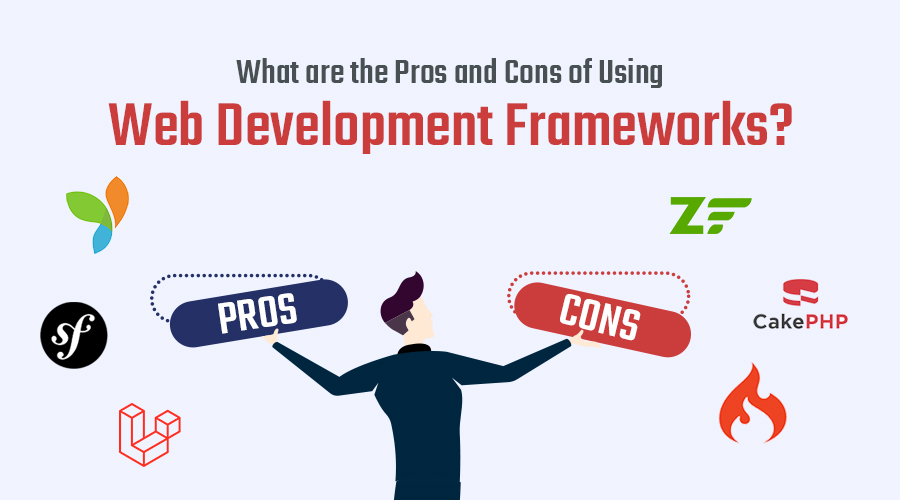
The world of web development has seen significant transformations, one of which is the advent of web development frameworks. These software platforms have undoubtedly simplified and accelerated the process of building and maintaining web applications.
Table of Contents
I. What is a Web Development Framework?
In the realm of web development india, a popular framework can be defined as a structured set of tools, libraries, and best practices that developers utilize to build efficient web applications. It’s like a blueprint for creating a house – it guides you with the design, layout, and construction process, enabling you to build robust and reliable structures.

This toolkit typically includes standardized, pre-written code in files and folders, which offer common functionalities that aim to ease the tasks of developers, allowing them to focus on the unique features of their projects. Some of the core features of web development frameworks include libraries for database access, templates, and session management, among others.
A web development framework also follows specific architectural patterns such as Model-View-Controller (MVC), which divides the application into interconnected components to separate internal representations of information from the ways that information is presented to and accepted by the user.
II. Common Types of Web Development Frameworks
There are several types of web development frameworks available today. Some of the popular ones include Django and Flask for Python, Ruby on Rails for Ruby, AngularJS, and ReactJS for JavaScript, Laravel for PHP, and ASP.NET for C#. Each of these has its own unique set of features and capabilities, which can be selected based on the project requirements.
III. Advantages of Using Web Development Frameworks
In the ever-evolving world of web development, achieving efficiency, security, and robust performance are key objectives for every developer. One of the most effective ways to attain these objectives is by using web development frameworks. But what exactly makes these frameworks advantageous? Why are they often the go-to choice for developers, from novices to experts?
Web development frameworks offer a structured and efficient way to build websites and web applications. They come packed with several pre-written modules and functions, which can be used to perform common tasks, thus saving developers from writing countless lines of code from scratch. This not only speeds up the development process but also ensures that the code is more organized, reliable, and maintainable.

In the sections to follow, we will dive deeper into the specific advantages that web development frameworks offer, from enhancing efficiency and code organization to offering robust community support, scalability, and built-in security features.
3.1. Efficiency
One of the most notable advantages of using a web development framework is the efficiency it brings to the coding process. These frameworks come equipped with pre-built functions, libraries, and templates that handle common programming tasks, thereby reducing the amount of code a developer needs to write from scratch. This accelerates the development timeline, allowing developers to focus on more unique, complex aspects of the web application.
2.2. Code Organization
Web development frameworks enforce a logical structure to the code, ensuring it’s organized and easy to maintain. They typically adhere to design patterns like MVC (Model-View-Controller), which encourages the separation of concerns and makes the code more readable and manageable. This well-structured code base significantly eases the process of debugging, updating, and scaling the application in the future.
3.3. Community Support
Most popular web development frameworks have a large, active community of developers supporting them. This implies access to a wealth of shared knowledge, including tutorials, documentation, forums, and pre-built modules. These communities also provide invaluable help when troubleshooting, making it easier to overcome challenges and keep the project moving forward.
3.4. Scalability
Web development frameworks are designed with scalability in mind. They provide a robust foundation that can handle an increase in web traffic as your application grows. In contrast, custom-built solutions might require substantial modifications or even a complete overhaul to accommodate growth, consuming more time and resources.
3.5. Security
Security is a paramount concern in web development, and frameworks often come with built-in protections against common security threats like Cross-Site Scripting (XSS) and SQL injection attacks. There are also third party tools available to augment integrated security systems. For instance, you can find Intruder’s XSS scanner online and implement it as part of an ongoing project. This reduces the vulnerability of your web application, giving you and your users peace of mind about data protection.
While web development frameworks do have their learning curves and potential downsides, the advantages they offer in terms of efficiency, code organization, community support, scalability, and security make them a popular choice among developers.
IV. Disadvantages of Using Web Development Frameworks
While web development frameworks offer a plethora of benefits, it’s also crucial to address the potential drawbacks that come with them. Understanding these pitfalls can help you make a more informed decision about whether to use a framework for your next web development project.
4.1. Learning Curve
One of the primary disadvantages of web development frameworks is the steep learning curve. Each framework has its own set of conventions, principles, and terminologies that developers need to understand before they can effectively use the framework. For complex frameworks like Django or Ruby on Rails, this could mean a significant time investment, which might not be ideal for every project or developer.

4.2. Performance Overhead
Another potential drawback of using frameworks is the potential performance overhead. Frameworks add an additional layer of complexity to your application, which can sometimes lead to slower performance. While this isn’t typically a problem for smaller applications, it could become an issue as your application grows and needs to handle larger amounts of traffic.
4.3. Limited Customization
While frameworks offer plenty of built-in functionalities, they might not cater to every specific need of your project. In some cases, trying to tailor the framework to your exact requirements can be cumbersome or even impossible without extensive modifications. This limitation could potentially restrict the creative freedom of developers and might lead to compromises in the application’s functionality or design.
4.4. Dependency on the Framework Community
Lastly, when you choose to use a particular framework, you become dependent on the community that supports that framework. If the community is active and growing, you’ll have plenty of resources and updates at your disposal. However, if the community is small or dwindling, you might find yourself stuck with outdated resources or facing difficulties in troubleshooting problems.
Remember, the success of your web application can be significantly tied to the framework you choose. Therefore, it’s essential to weigh these disadvantages against the advantages before making a decision.
V. Conclusion: Is It Worth Using a Web Development Framework?
The answer to this question largely depends on your specific needs and circumstances. If you’re working on a complex project with a tight deadline, using a web development framework can save you significant time and effort. However, if your project requires a high degree of customization and you have concerns about performance overhead, going with a framework might not be the best choice.














![[SALE OFF] Discount 30% Off All Products On Christmas And New Year 2024 Christmas & New Year 2024 sale off from Landofcoder](https://landofcoder.b-cdn.net/wp-content/uploads/2023/12/xmas-banner-900-x-500-px-3-218x150.png)




